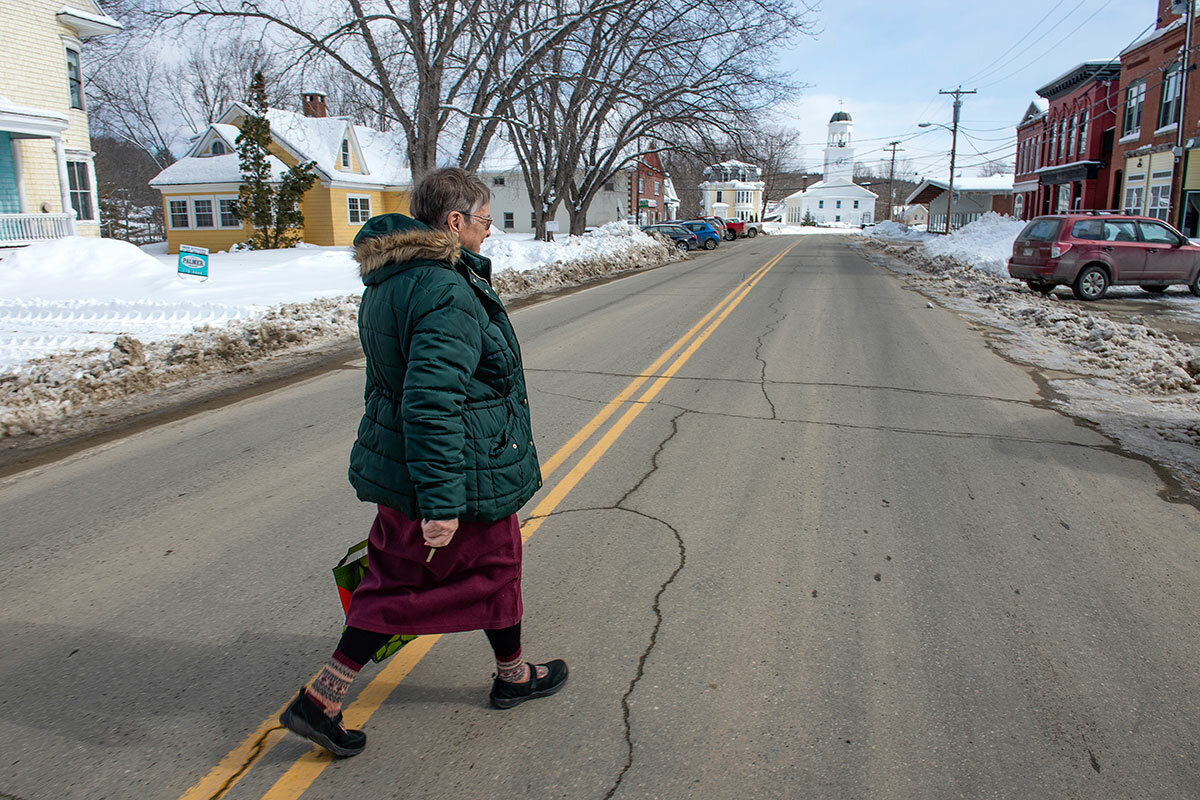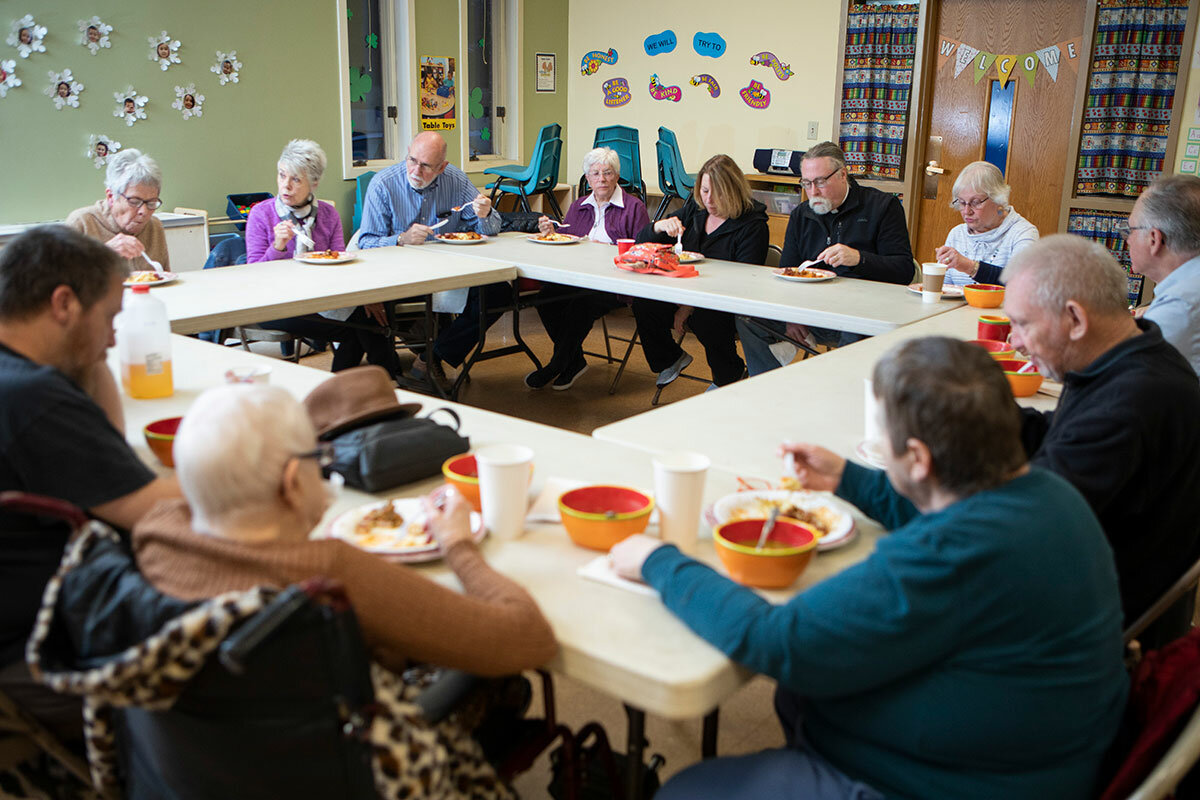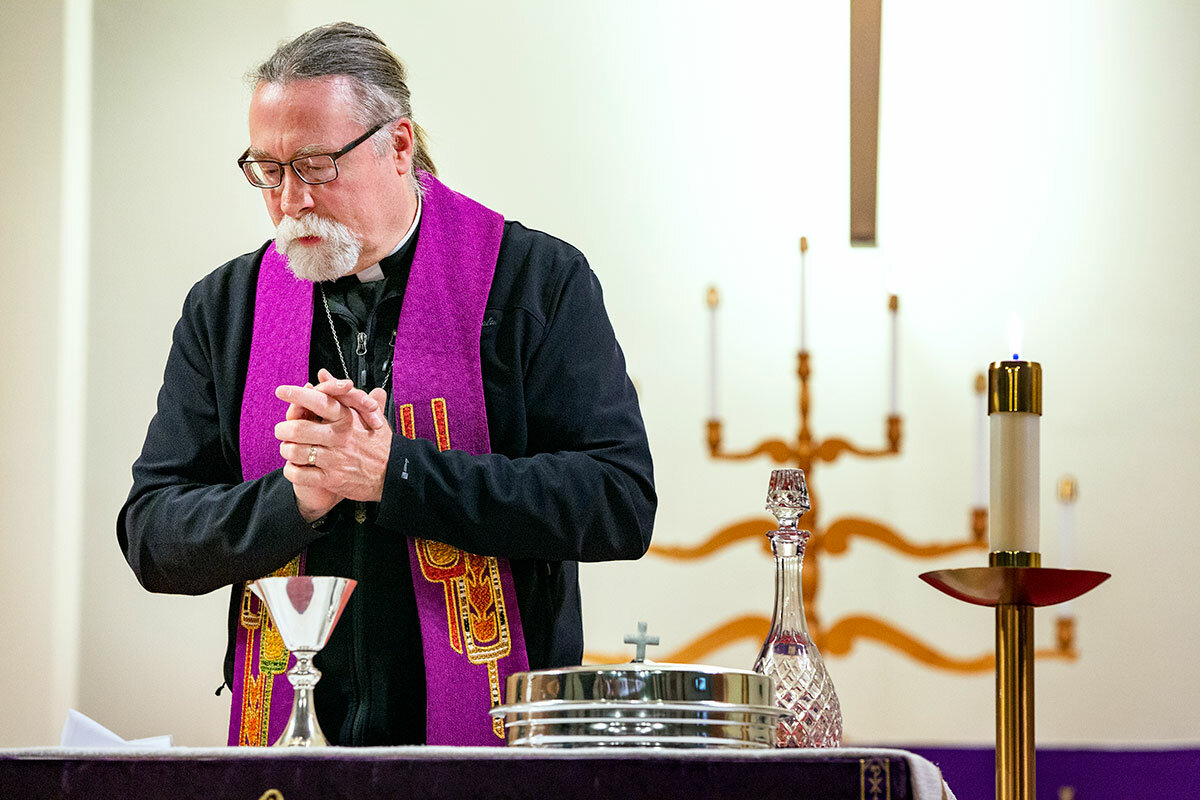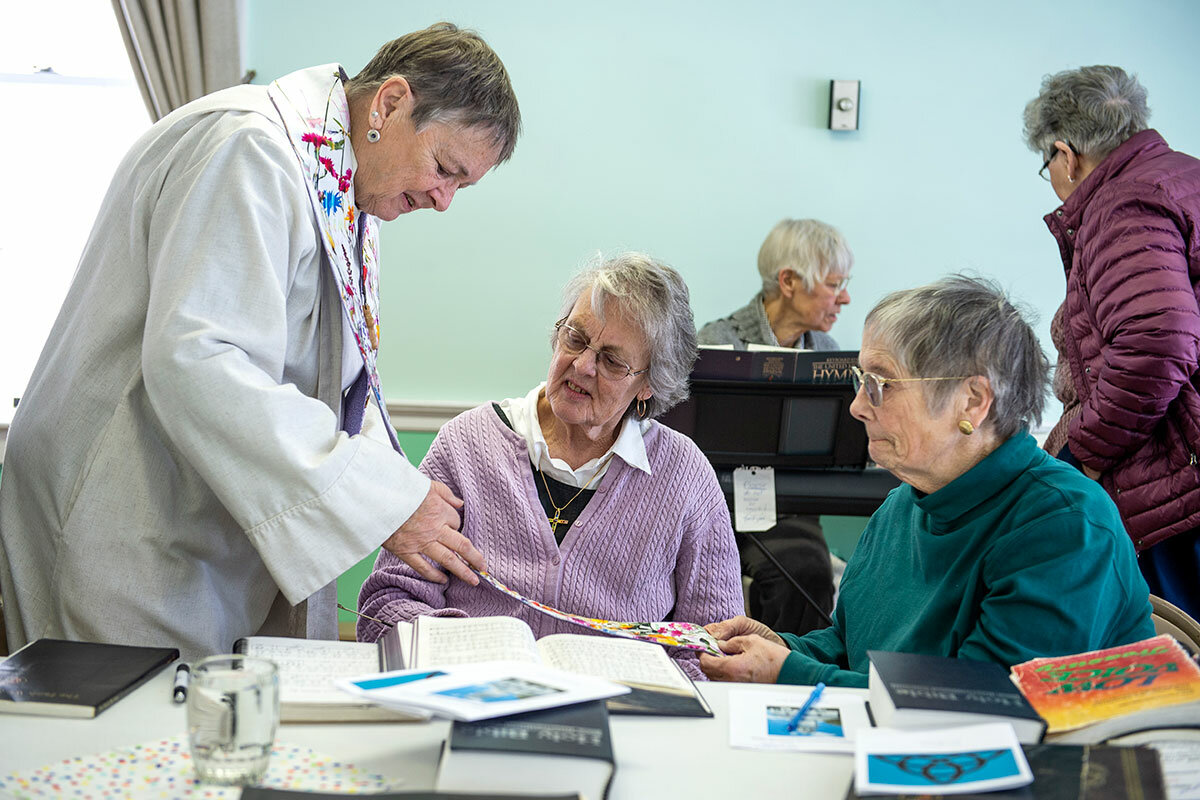Pastor-sharing: For clergy, a holy hustle and labor of love
Loading...
| Phillips, Maine
The Rev. Susan Tierney had already done what would have been a good Sunday’s work for any clergyperson. Then she got up in front of her second congregation to do it all again.
She’d risen before dawn at her home in Pittsfield, drove 70 miles across rural western Maine, and led worship for 19 people huddled close (pre-coronavirus outbreak) at Weld Congregational Church on a crisp early March morning. No sooner had the benediction ended than she was in her red 2009 Subaru Forester, adding to the 177,000 miles on the odometer by racing around Mount Blue on a rutted 20-mile road to Phillips Congregational, her other church.
Editor’s note: As a public service, we’ve removed the paywall for all our coronavirus coverage. It’s free.
Why We Wrote This
Pastors often served multiple congregations in Colonial days, traveling from church to church on horseback, to meet the needs of an expanding nation. Now minister-sharing is returning for another reason: as a resourceful way to sustain worship with fewer people in the pews.
Now she was standing at a lectern before nine women and one man, all seated at tables in the church-owned community building, waiting for an encouraging word. They really needed it. Two blocks away, their hulkingly prominent white church sat empty, mothballed behind snow-covered steps.
The sermon she’d delivered in Weld wasn’t going to work here. Her call to confession from the Weld pulpit would have been too bracing in Phillips, an economically struggling town where defunct factories no longer churn out clothespins, matches, or shoes. Congregants had just voted in February to sell their church building and cut back on clergy-led worship from weekly to monthly. They could afford nothing more, but they felt guilty nonetheless about the ministry winding down on their watch. So the pastor customized a spiritual meal that she felt they needed.
“Our Easter will come, and we will know it for the promise of God, who has promised us good things,” Ms. Tierney assured her flock. “But we will not see the dawn if we only look backwards toward the darkness. Rest in God’s love. That is your call for this Lent.”
Ms. Tierney is symbolic of a centuries-old model of ministry that is making a comeback in the United States as individual pastors cater to multiple congregations in a time of financial and spiritual need. From Maine to California, Minnesota to Florida, congregations are sharing clergy as attendance declines and churches seek resourceful ways to sustain a variety of ministries.
The pastor-sharing is happening across time zones and across denominations, from the mainline Protestant churches to Unitarian Universalism and Roman Catholic parishes. It’s a practice that requires stamina – just ask one New Hampshire Episcopal priest who races every Saturday in winter from a Mass atop Mount Sunapee, where he presides in black cassock and ski boots, to an indoor service 11 miles away in Newport, New Hampshire. The next morning, he’s in a third town for two more services, starting at 8 a.m.
Yet pastor-sharing is helping to revive some small churches and changing the culture in the pews in unexpected ways. Does this brave new world of sharing clergy represent just a pragmatic solution to burdensome budgets? Or is it part of a modest reinvention of American religion and its basic building block, the congregation?
One thing is certain: The trend is growing. Some 44% of the United Methodist Church’s 45,000 churches now share a pastor. In the United Church of Christ (UCC), which includes Weld and Phillips among its 3,277 congregations, 11.1% of churches share a pastor, up from 9.4% in 2016. Preliminary results from the not-yet-released 2018 National Congregations Study suggest the percentage of churches sharing pastors might be climbing across mainline Protestantism as a whole, according to NCS Director Mark Chaves of Duke University.
The main driver is money. Congregations that used to be able to afford full-time clergy can’t cover the costs of salary and benefits in a time of declining church attendance and lighter offering plates. In 2018, fully 43% of mainline churches already had no full-time clergy all to themselves, according to NCS preliminary data that suggest many work a second job, either religious or secular. The coronavirus-induced economic crisis of 2020 is apt to push that percentage even higher.
Tradition with a twist
Such pressures are rekindling a shared ministry model that helped build America’s church landscape. Anglicans routinely shared clergy in Colonial days because trained priests were too scarce for every church to have its own, according to E. Brooks Holifield, author of “God’s Ambassadors: A History of the Christian Clergy in America.” One church might sponsor as many as nine chapels that a priest would visit occasionally to administer sacraments. As the frontier was settled, Methodists assigned preachers to circuits, or a string of churches that the horse-riding clerics would check on and feed with word and sacrament every few weeks.
The shared pastor model “goes back a long way, but it’s coming back,” says Mr. Holifield, a historian of American religion.
While population shifts are helping to fuel the trend today, as it did back then, it now comes with a new twist. Mainline congregations are no longer sharing clergy in an ambitious bid to reach a growing country. Burdened with aging church buildings and other costly structures, they’re trying to scale back to a sustainable footprint, especially in small towns that are losing residents.
“It looks the same [as in centuries past], but the underlying dynamics are different,” Mr. Holifield says. “In the early 19th century, the issue was rapid geographical expansion. In the 21st century, the issue is more one of contraction – having to cut back on things so that churches that once were able to afford a full-time pastor often now cannot.”
Moving to shared clergy means a church is reaching beyond its walls for new support, but to what end can vary widely. Depending on the setting, it can be a way to keep church doors open or launch an experimental format. No matter what the circumstances, it challenges pastors and congregants alike to set priorities and accept trade-offs.
All of that is on display in America’s most secular region, New England. From rural corners to urban downtowns, congregations are entering new stages of life with pastors who aren’t theirs alone. And they’re finding that means a lot more relationships come to bear on shaping their futures.
Holy hustle
Inside a stone church off the main road in Newport, a congregation of 17 gathers for worship on a Saturday at 5 p.m. even though there’s no fixed furniture to sit on. The pews at Church of the Epiphany were removed, along with assumptions that every church needs a priest all to itself, as part of a relaunch of the congregation in 2017.
Chancel and pulpit, once reserved for a choir and collared cleric, now go unused. Instead the Rev. Jay MacLeod – who also serves as rector of St. Andrew’s Episcopal Church in New London, New Hampshire – mills among the people, animatedly preaching to them in a partial circle of folding chairs before leading the congregation to the altar for Holy Communion.
Epiphany hasn’t always had so many signs of fresh thinking and new life. The church had dwindled to about a dozen people before its part-time priest suddenly retired in 2015 after a family tragedy. The future was uncertain for this cash-strapped congregation in a town struggling with poverty.
“Epiphany had a choice to make,” says Aaron Jenkyn, who coordinates outreach and pastoral care at Epiphany and St. Andrew’s. “They had to decide if they were going to shut down, join with another church, or push through and make some big changes to the way that they were doing church. And they bravely chose to make big changes.”
Teaming up to share a priest with St. Andrew’s, a larger and more affluent parish, has been as significant as moving worship to Saturdays, renovating interior space, and launching two after-school enrichment programs. One reason: Congregations that share a priest qualify for grants that they otherwise couldn’t get, according to Tina Pickering, canon for ministry development in the Episcopal Diocese of New Hampshire. With grant support, Epiphany is able to provide free music lessons and 4-H programming for neighborhood young people from low-income homes.
The church feels it’s getting a bargain. For $9,000 a year, it gets Mr. MacLeod sometimes after school for the music program, for pastoral support in times of crisis, and every Saturday for Mass. In winter, he officiates in ski pants because he’s just been atop Mount Sunapee serving Holy Communion to skiers. Nobody seems to mind the informality.
“We want to see this parish survive,” says Epiphany member Gene Jannenga. “The only way we’re going to be able to do it is to do what’s happening in other parts of this region” by forging partnerships, including priest-sharing.
The arrangement seems to be working. Average weekend attendance has doubled since 2015, to 24. Once a month for worship, the congregation offers Messy Church, a popular casual, intergenerational format that drew 65 to Epiphany one Saturday in February.
For Mr. MacLeod’s part, hustling between churches can contribute to feeling emotionally and physically fatigued, he says. But working with young people in Newport is a highlight of his week. The ambitious schedule also fits his personality: A Rhodes scholar with three degrees, he enjoys being challenged.
What makes the partnership tough at times is the long-standing class divide between St. Andrew’s and Epiphany.
“Prone to an inward-looking, country club ethos, St. Andrew’s needed to develop a stronger sense of its own vocation,” Mr. MacLeod says in an email. “St. Andrew’s supports ministries in Haiti, Honduras, the Middle East, and Navajoland as well as disadvantaged Boston youngsters, but supporting our neighboring parish in Newport has probably raised more eyebrows. I suspect most people are coming around.”
Sharing a priest has helped bridge that gap, churchgoers say, because Mr. MacLeod’s two flocks rub elbows in ministry trenches. Dozens from St. Andrew’s volunteer at Epiphany’s programs for children, and they’re bringing insight back to New London. In January, for example, St. Andrew’s began hosting its own Messy Church once a month.
“At first it was very awkward” to volunteer alongside folks from St. Andrew’s, says Linda Radford, an Epiphany member since 1965 and a Newport resident. “I’ve always felt like New London was a little above us, and they might look down on us a little bit. I think that was difficult at first, but now I don’t feel that.”
‘One big parish’
Kate Valleli has always belonged to a Lutheran church and wants the same for her three children. When she was growing up, her military family would find the flock in every community in which they lived. It kept them connected to their German Lutheran roots, to new friends, and to God.
What makes the family tradition sustainable in central Massachusetts, where the Vallelis now live, is a pastor-sharing arrangement between two congregations that couldn’t afford a full-time clergyperson on their own.
Because Zion Lutheran in Worcester and Bethel Lutheran in Auburn have teamed up, the family takes part in youth programming at Bethel and urban outreach at Zion. The unifying factor is their pastor, Andrew Borden, who serves both churches under the auspices of Grace Ministries, a framework in which Zion and Bethel act as yoked congregations employing him together.
“If it were just this campus, there would be fewer and fewer outreach programs happening because of the demographics,” with Zion’s aging makeup, Ms. Valleli says, as she serves shepherd’s pie at Zion’s neighborhood meals program for older people in Worcester. “Pastor is trying to bridge that by bringing more able people from the other congregation to bring things alive here.”
Stories like the Vallelis’ affirm that the two churches offer more together than apart. It helps them survive the costs of maintaining multiple properties.
Mr. Borden tries to be present wherever he’s needed and spreads himself thin at times. When he leads midweek worship in Lent, he scrambles from the altar over to play the piano. He oversees at least four buildings as reflected in the jangling key ring on his belt loop. When a tenant lease needs renegotiating, he gets involved. And when services are closely scheduled, he arranges for a lay leader to start things off so that he can arrive partway through the service, don vestments, and step in.
“I look at it as being one big parish with two geographical locations,” Mr. Borden says. “At one rehab facility, I might be visiting a person from one campus at 10 o’clock and see someone from the other campus there at 11 o’clock. For me, I don’t have to worry about ‘am I giving time here or am I giving time there’ because it’s all a blend. I just go and do.”
The pastor-sharing comes at a price, however, for people like Bill Toombs, a retired garbage collector. He used to attend Lenten suppers weekly at Zion, his neighborhood church. Those seasonal sessions still happen, but every other week they’re now at Bethel. That means he has to load his octogenarian mother-in-law and her wheelchair into a van for the 9-mile ride to Auburn if they want to take part.
Time with the pastor can be hard to get, too, Mr. Toombs says. He likes to talk with Mr. Borden about common interests or changes in family life, but seldom gets a chance.
“He gets done here at quarter to 10 and he has to be down there at 10 o’clock,” Mr. Toombs says at a lunch for neighborhood seniors at Zion. “Sometimes you have something like a death in the family and want to talk to him, but he’s running out the door to the next church.”
Mr. Borden has been trying to make the arrangement work since 2015 when Zion, where he’s been since 2007, could no longer afford to pay him full time. Bethel has the larger and younger congregation. So which one gets him at prime hours on major holiday events like Christmas Eve?
“There’s a really strong preference for ‘well, we need the early service [at Zion] because we have 30 people for dinner and it starts at 6 o’clock,’” Ms. Valleli says. “People are just rigid about – you can’t change that. But if we have a bigger congregation over there [at Bethel] and a bigger turnout, that’s where he’s going to be.”
Sharing a pastor can mean revitalizing a congregation or helping one wind down. In Weld and Phillips, Ms. Tierney is doing both at the same time. Like many rural flocks, the Congregational church in tiny Weld (pop. 419) has struggled at times to survive financially.
A few years ago, parishioners were worshipping in the parsonage all winter so they wouldn’t have to heat the main church building. But having a shared pastor arrangement has helped free up funds, including for building expenses. The congregation now holds services in its classic white-steepled church building even on chilly winter days, with fleece blankets offered on pews for extra warmth.
Switching back to the traditional venue has helped attract relatively new members such as Tom Skolfield, who felt the church should meet in its meetinghouse. And having a pastor who specializes in tending to small congregations has been a bonus.
“She has the ability to make both churches feel like they are No. 1,” says church member Mike Pratt.
Average Sunday attendance at the Weld church has climbed from six in 2015 to about 25 now in cold weather months. In summer, attendance swells to between 30 and 50 on a typical Sunday. With a picturesque lake on one side and a popular state park on the other, Weld has benefited from its growing popularity with vacationers. They also tend to give generously.
Phillips Congregational Church had hoped Ms. Tierney’s presence could bear new fruit, much as it has in Weld, but sharing a pastor – even a small-church specialist – didn’t lead to similar results.
“She came here to help us as a small church, but nothing seemed to make any difference here in this community,” says Mary Dunham, a longtime church member. “It didn’t increase our congregation at all.”
Despite having the same pastor, the churches are moving in opposite directions. That’s partly because they’re barely connected. They happen to contract with the same clergyperson but don’t coordinate compensation or expectations. As Congregationalists in the UCC, they rely more on local governance than do Lutherans or Episcopalians.
Another reason is location. Weld is more stable economically than Phillips, which has battled decline for decades. The Phillips church’s history of sharing pastors with other congregations dates to the 1970s, when the community was losing manufacturers. Despite sharing pastors with churches of the UCC and the United Methodist Church through the years, nothing has reversed the fortunes of Phillips Congregational Church or the town.
“When I was a kid growing up, Phillips had everything you could ever think of – it was a booming community,” says Paul Gardiner, the son of two workers at Phillips’ long-closed Diamond Match factory. “We had a hardware store, movie theater, doctors, dentists, lawyers, and all that stuff. They’ve all gone.”
After a career that’s included stints as a police officer, deputy sheriff, and fire chief in town, Mr. Gardiner now owns a lawn-care business and longs for a renewal of traditional values. “Bunch of young kids don’t care about doing anything that the older people do,” he says. “How many young people bring their kids to church anymore?”
In March, Phillips Congregational entered yet another new phase. The church ended Ms. Tierney’s weekly sermons. Instead she will now visit once a month. During the pastor’s last time behind the pulpit on her regular schedule, two of the three members of the choir wept as they sang “Keep Me Safe as the Storm Passes By.”
“I feel like we didn’t do enough to inspire people to be here,” says Ms. Dunham. “I mean, God is the center of my life. I can’t go a day without Him. I get up early just so I can read and start my day with Him. I just wish other people could feel what that does for them.”
The pastor, in her own way, offered reassurance to Ms. Dunham and her fellow parishioners in her sermon. “Do not use this time to struggle to figure out our situation or try to understand what comes next,” Ms. Tierney said. “What I ask of you in this season of Lent is just to rest in hope and take in nourishment from God’s always-devoted love.”
A culture transformed
As churches increasingly share pastors, they’re entering what promises to be an extended transition – one that can be challenging for both clergy and congregants.
“The grief is over the loss of what once was and isn’t coming back, and [the] loss of identity,” says Richard Simpson, canon to the ordinary in the Episcopal Diocese of Western Massachusetts. “What makes this work [of clergy-sharing] hard is that the clergy themselves are going through it alongside the congregations they serve.”
What emerges from these partnerships runs the gamut from the daunting to the invigorating to the experimental. Sharing clergy brings new partners into the life of a congregation, not only a pastor but also congregants of a sister church. This means more experiences, new sensibilities, and transformed church cultures – all of which factor into decision-making. And with more influences come more ideas and possibilities.
“We are preparing ourselves for a new kind of life that we believe will be revealed to us,” Ms. Tierney tells her flock in Phillips. “Do not worry. Just look for signs of what we believe will be our spring rising.”
Editor’s note: An earlier version of this story incorrectedly reported an imbalance in how Pastor Borden's salary is sourced. He is paid equally by his two congregations.
As a public service, we’ve removed the paywall for all our coronavirus coverage. It’s free.









